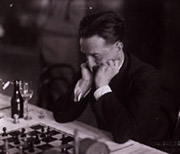Short Fuse: Diana Thater — Chess and Chelsea
by Harvey Blume
Marcel Duchamp famously tweaked art for being inferior to chess, saying: “From my close contact with artists and chess players I have come to the personal conclusion that while all artists are not chess players, all chess players are artists.” Duchamp backed this opinion up by abandoning art for years to pursue what he believed to be the greater intellectual and aesthetic rewards of chess.

Duchamp playing chess sometime during the 1930s
In fact, the argument can be made that Duchamp resigned himself to becoming a legend of the art world only because he didn’t quite have the talent to become a legend of chess world. It is tempting, then, to wonder what Duchamp might have made of Diana Thater’s installation, “Here is a text about the world,” in which a chess fetish meets Chelsea art world convention. (David Zwirner Gallery, 525 West 19th Street, Manhattan, January 10 – February 9).
The show consists of black and white videos of male and female hands pushing chess pieces and pummeling chess clocks. The games being reenacted include acknowledged masterpieces. There is, for example, what has come to be known as the Immortal Game, played between Adolf Anderssen and Lionel Kieseritzky in a pub in 1851 during the lead-up to London’s great Crystal Palace Exhibition. Anderssen pulls off an unlikely mate of his opponent after having sacrificed the best part of his own forces in a devilishly wild but well-planned assault. It’s a bravura finish, even though it would be next to impossible to replicate today because chess, like art, has a history, and the game, especially with respect to defense, has moved on. In fact, you could say that a key distinction between chess and art is that chess, unlike art, has indisputably improved over time.
Disembodied hands play out more recent games as well, including one from the match Garry Kasparov lost in 2003 to IBM’s Deep Junior. This outcome was disputed, Kasparov claiming the machine hadn’t beaten him on its own but was coached by a team of grandmasters during adjournments. Kasparov argued further that he was hampered by Deep Junior, or its programmers, having access to all his previous games and preparing accordingly, whereas he was denied even a glimpse into Deep Junior’s chess past.
 The Immortal Game Adolf Anderssen vs. Lionel Kieseritzky June 21, 1851 London (Played by Nathaniel Lagemann and Jennifer Acon) 2008
The Immortal Game Adolf Anderssen vs. Lionel Kieseritzky June 21, 1851 London (Played by Nathaniel Lagemann and Jennifer Acon) 2008
Obviously, the more chess you know, the deeper your appreciation will be of “Here is a text about the world”. But you have to bring chess smarts with you, the show being steadfastly uninstructive about the mechanics or the logic of the game. Thater’s videos show that she is as much a hand as a chess fetishist, deftly recording the by turns hesitant and energetic dance of fingers and pieces. There is something hypnotic about this interplay, but there is also an art world coolness to it, an arch refusal to divulge.
Would it have hurt the filmmaker, for example, to project notation for the moves on the wall alongside the games? Doing so would have complemented the visual allure with the sense that logical coherence, however arcane to non-players, lay behind it — except in fanciful games like the one from Lewis Carroll’s Through the Looking Glass, where it didn’t.
 Blitz 2008
Blitz 2008
I felt the dearth of chess data — it’s even difficult to know which videos represent which games since the handout can’t be read in the darkened gallery — would have made Duchamp restless before too long. I suspect that after appreciating the breezes blowing hands and pieces around the boards he would have ducked downtown to a chess club looking for a real game.
Tagged: David-Zwirner-Gallery, Diana-Thater, Marcel-Duchamp, Short Fuse, chess
